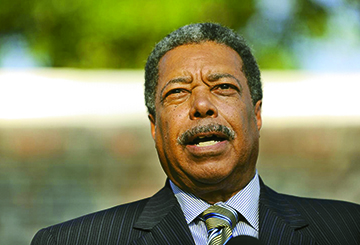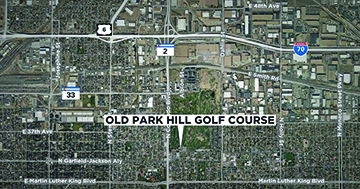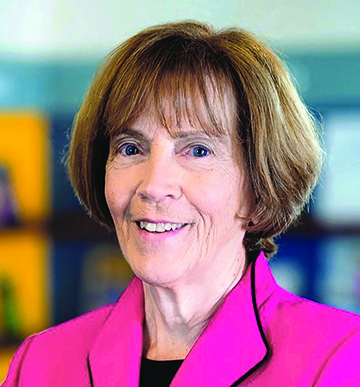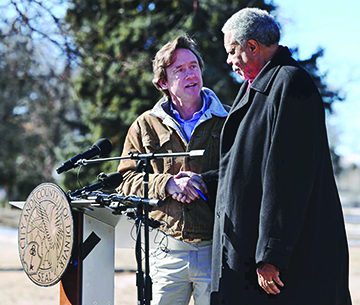155 Acres Will Be A Permanent Park
Wellington Webb Hailed As A Hero
by Charles C. Bonniwell

Victor: Former Mayor Wellington Webb helped lead the years-long struggle to keep the old Park Hill Golf Course as Open Space and not a dense mixed-use development.

Coming Soon: The old Park Hill Golf Course will be converted into a regional park to open this summer.
A decades long battle on whether the 155 acres which comprised the old Park Hill Golf Course would be a permanent park and open space or paved over for a dense mixed-use development has finally reached a conclusion. The Park Hill residents overwhelmingly appeared wanting an open space park but aligned against them was a developer (Westside Investment Partners) who stood to make tens of millions of dollars from development with the strong backing and power of the mayor, City Council, and all of the agencies of city government. It appeared inevitable that the development would occur notwithstanding what the residents earnestly wanted. Citizens almost never win this type of battle yet this time it was different.
Opposing the developer/government juggernaut was an underfunded rag tag residents group by the name of Save Open Space Denver (SOS) in conjunction with former Denver mayor (1991 to 2003) and Park Hill resident Wellington Webb. Notwithstanding the David versus Goliath nature of the battle, on January 15 the present Denver Mayor Mike Johnston announced that the city had engaged in a land swap whereby Westside Investments would be given 144 acres of empty industrial zoned property near the Denver International Airport for the 155 acres of the old Park Hill Golf Course. The swap ensures that the Park Hill acreage would be a city park, the fourth largest in the City and County of Denver and the largest acquisition of park land in the city’s history. It makes certain that the entire greater Park Hill neighborhood will continue to be one of the gems of Denver. The tale of this miraculous victory by the residents over their own government and a powerful developer is one of the most heartwarming tales of 21st century Denver.
Park Hill
What is today the Greater Park Hill neighborhood began in 1887 when the German Baron von Winkler sought to subdivide 32 acres of land east of Colorado Boulevard for an upscale re

Clayton College Campus: The Clayton College campus was designed by Maurice Briscoe and Henry Hewitt in the Italian Renaissance Revival-style with sandstone masonry.
sidential neighborhood. The Silver Crash of 1893 greatly hindered his plans. In 1898 he committed suicide with the poison strychnine and a gun, but his dream of development would slowly be fulfilled.
Today, Park Hill, sometimes referred to as Greater Park Hill, has approximately 30,000 residents divided into three distinct neighborhoods running up Colorado Boulevard. It starts with South Park Hill running from 17th Avenue and ending at 23rd Avenue. It is predominately white, affluent,

Location: The new park will be at the southwest corner of the Northeast Park Hill neighborhood along Colorado Boulevard.
and contains some of the most beautiful homes in all of Denver. Next is North Park Hill which runs from 23rd Avenue up to Martin Luther King Jr. Boulevard (formerly 32nd Avenue). It is generally affluent but less than South Park Hill and is more evenly split between black and white residents. Further north is Northeast Park Hill which runs from Martin Luther King Jr. Boulevard to 53rd Avenue. It is largest of the three neighborhoods in size, but smallest in population and the least affluent. At one time Northeast Park Hill had an overwhelming black population. In recent years Hispanic and white residents have been increasingly moving in.
The Estate
The Park Hill Golf Course property is on the southwest corner of Northeast Park Hill starting on Colorado Boulevard and just north of Martin Luther King Jr. Boulevard. The story of the golf course goes back to 1889 when a successful businessman, George Washington Clayton, was found dead slumped over his desk. With his wife and child having predeceased him, he left his fortune and property to the city of Denver for the purpose of an orphanage for white boys born in Colorado from respectable families. Racism, class division, and corruption would be a constant theme regarding his estate and Park Hill. The estate was valued at $2 million dollars in 1889 which is equivalent to $75 million today and his estate included numerou

Jackpot Winner: Charlotte Brantley as CEO of the Early Learning Center came out as the big monetary winner regarding the old Park Hill Golf Course. She sold on behalf of the Early Learning Center/Clayton Trust a conservation easement on the Park Hill Golf Course but then turned around and sold the land to Westside for $24 million as if no conservation easement existed.
s real estate properties.
Federal judge Moses Hallett was made the executor of the estate and charged with creating the orphanage. In 1903 he was accused of mismanaging estate funds, including using assets for his own purposes, and illegally
paying himself from estate funds. Nonetheless, under his tutelage the construction of the orphanage was completed by 1910 to be called Clayton College for Boys and turned it over to the city in 1911.
The Golf Course
The estate became the George W. Clayton Trust with the City and County of Denver as the sole Trustee. The orphanage was housed i

Ceremony: Mayor Mike Johnston brings up to the podium the victorious former Mayor Wellington Webb at a January 15, 2025, press conference announcing the land swap and creating a regional park at the old Park Hill Golf Course.
n beautifully constructed buildings and called Clayton College for Boys. Across Colorado Boulevard from the buildings at Martin Luther King Jr. Boulevard was a 155-acre dairy used to help teach the orphans agricultural skills. The dairy farm operation ceased and in 1932 the land became the Park Hill Golf Course under a lease agreement with an operator.
The City and County of Denver as the sole Trustee proved to be no less corrupt than federal judge Moses Hallet. The city managers of the estate were found to be selling trust properties to friends and business associates at far below fair market prices and other acts of self-dealing. In 1982 the city was replaced by a foundation called the Clayton Foundation with no assets and a volunteer board to be the sole trustee of the Clayton Trust.
The orphanage was closed in 1957 due to the lack of boys fitting the restrictive provisions. In 1969 the Colorado Supreme Court court amended the provisions of the trust to eliminate the restrictions with regard to race, gender, and family background. In 1991 the Clayton Foundation became the Early Learning Center for the purpose of assisting low-income families with children from birth to three years old. In 1995 it became associated with the federal Head Start program. Critics have declared the program to be little more than a federally supported day care center whose main beneficiaries were the overwhelmingly white female teachers and administrators who paid themselves handsome salaries along with generous perks and pensions. It was ruefully noted that the Early Learning Center was as racially segregated as Clayton College for Boys with the white female teachers serving almost exclusively black and Hispanic families with no white male boys in the mix.
Like the managers and trustees before them, the white female teachers and administrators led by CEO and president Charlotte Brantley, were accused of attempting to convert the assets of the trust (the Park Hill Golf Course land) for their own benefit.
Marketing The Property
The 155 acres is located on the southwest corner of Northeast Park Hill. In the 1950s and 1960s real estate agents and bankers started a real estate stampede known as “white flight” by going door-to-door telling white residents that they needed to sell as soon as possible because blacks from Five Points were increasingly moving in causing property values to plummet.
Eventually many of Denver’s black political leaders came from Park Hill including Denver’s first black mayor Wellington Webb. In 1997, in order to prevent the land from being sold to developers to meet the money desired by the Early Learning Center, Webb arranged a deal whereby the city paid two million dollars to the Early Learning Center in return for a conservation easement on the land, whereby it was to remain a golf course or open space.
The Early Learning Center quickly blew through the 2 million dollars and soon hunted for more funding. In 2011 Micheal Hancock became the second black mayor of Denver, but unlike Webb had no interest in parks and open space and was almost universally deemed to be in the back pocket of developers. Neither the Hancock Administration nor Early Learning Center seemed to care that the property had a conservation easement for open space on it which the citizens wanted to keep. The Early Learning Center’s Brantley started talking about envisioning the 155 acres, but no mention of returning to the taxpayers the money it had taken.
In 2017, a convoluted agreement was drawn up with the city buying the land for $20 million and indicating the Early Learning Center would jointly develop the property. The agreement was so convoluted that the City Council balked.
Wellington Webb wrote: “In 2017 the Denver city administration and the landowner, Clayton Trust [managed by the Early Learning Center] , thought they would be able to terminate the conservation easement between themselves simply with a wink and a nod and city council approval. Had it not been for Arcis Golf, the company that operated the golf course crying foul, termination of that agreement would have flown under the radar, tucked into a measure for a vote by Denver City Council to approve the sale and development of that 155-acre, tree-filled green space.”
Before that litigation was resolved the state legislature enacted a new law in which an impartial judge would have to rule that conditions had to have changed so that the purposes for easement no longer existed. The legislation appeared to save the land as open space but no. A Denver judge would later rule quixotically that the citizens had no standing to enforce the easement.
The Rise Of Opposition
But the initial contract to sell and subsequent lawsuit alerted Park Hill residents that Park Hill Golf Course land would be paved over for development unless they organized and fought back. SOS was formed with the help of two lawyers, Penfield Tate III and Woodsey Garnsey, soon to be joined by Webb.
In 2018 the golf course was closed and in 2019 Clayton Early Learning announced that it had agreed to sell the land to Westside Investment for $24 million, which shocked observers since the property was worth about $3 million with the conservation easement. It was assumed the fix was in with the Hancock Administration agreeing to lift the easement and approve any redevelopment.
Westside and the City then went on a full-bore public relations campaign to get the public behind the redevelopment. The city hired a firm to poll what the citizens wanted for the area which unsurprisingly came out with affordable housing. SOS was able to show that reality using a push poll, whereby the questions led the person being polled to the conclusion that the poller wanted. The city also set up the Park Hill Golf Course Area Visioning Process whereby city staff would meet up with various neighborhood groups to work through what they wanted to do with the land. The city staff, of course, were not honest brokers, which was demonstrated when they threw SOS out of the process saying that only those who wanted redevelopment could participate and not groups hoping to keep the property as an open space park.
SOS however continued to be proactive. It put on the November ballot Ordinance 301 which would require a citywide vote approving the lifting of a conservation easement. Westside then also got Ordinance 302 on the ballot which required such a vote in all cases except Park Hill Golf Course. SOS crushed Westside at the polls with Ordinance 301 winning with over 60% of the vote and Ordinance 302 losing by the same margin.
Westside through generous campaign contributions directly and indirectly had control over a large majority of the 13-member City Council. Westside got its small area plan approved by an 11-2 margin. The City Council also hoped that a scheduled April 4 vote on lifting the conservation easement would be favorably influenced by the approved redevelopment plan.
With tens of millions at stake Westside threw in everything it could including the race card. Westside and the City proclaimed if the land was a park it would make the area far more attractive and “gentrify” the area. Gentrification was a code whereby affluent whites would buy up properties

Driving Force: Andy Klein, the founder and CEO of Westside Investment Partners employed every trick and artifice to turn Park Hill Golf Course into a mixed-use development but ultimately failed to overcome the Park Hill Residents desire for a park.
displacing blacks. It is the flipside of “white flight.” The Westside redevelopment plan provided significant affordable housing which would attract black buyers and keep the area with a majority of black residents.
Given the enormous resources Westside would pour into the racist flavored campaign, and how little SOS and the other neighborhood groups had to spend, it was assumed Westside would win. To the shock of many Westside lost badly with over 60% voting to keep the conservation easement.
The Stunning Swap
Wellington Webb and the neighborhood groups had stopped the redevelopment of Park Hill Golf Course by their incredible election victory but were not any closer to making it a park. Westside still owned the land subject to a conservation easement which allowed golf course operations as well as open space. In a pique of anger Westside fenced off the property and did minimal maintenance.
Westside also threatened to turn a part of the property into a multi-story Top Golf driving range serving alcohol with loud music. Mayor Hancock had declared that the city would never buy land for a park, as it was way too expensive for the city budget.
For open space advocates the long nightmare of Mayor Hancock was to be over in 2023, with the mayor term-limited out of office after 12 long years. But the leading candidates appeared no less unfriendly to parks and open space. While the two runoff candidates, Mike Johnston and Kelly Brough, agreed on very little but they did agree that the property should be redeveloped by Westside and not become a park.
It was therefore one last surprising turn of events concerning the Park Hill Golf Course when Johnston announced on January 15 of this year that Denver was acquiring the land for 144 acres of industrial zoned land close to the Denver International Airport to swap for the old Park Hill Golf Course. The 155 acres will become a regional park improved and maintained by Denver Parks and Recreation.
At the press conference the mayor recognized Penfield Tate and Woody Garnsey of SOS and brought up Wellington Webb to a hero’s welcome.
The residents had, against all odds, “beaten city hall.” Future generations of Park Hill residents will be the beneficiaries of the unbelievable fight and victory of Wellington Webb, SOS, and an intrepid band of fighter residents from the Park Hill neighborhood.
